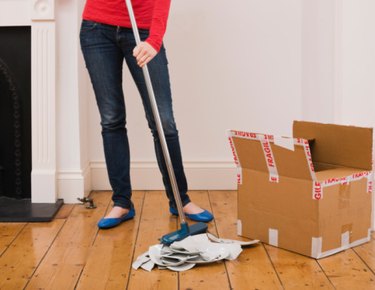Things You'll Need
Rubber gloves
Bucket
Water
Liquid dish soap
Bleach
Vacuum

Dirty brooms and mops will not clean effectively. In addition, germs and bacteria can thrive on a dirty mop, according to Allergy Consumer Review. If you maintain your mop properly and clean it regularly, you should not even have to replace the mop head. Brooms also last longer if they are regularly cleaned. Both nylon and straw brooms should be cleaned each time you notice grit and debris buried deeply within the bristles. Clean mops after every use.
Mops
Step 1
Pull on some rubber gloves. Rinse the mop in clean, warm water. Remove large pieces of debris from the mop head by hand as you rinse it out.
Video of the Day
Step 2
Place the mop head-down in a bucket of hot water mixed with a sterilizing agent such as bleach. Use a teaspoon of bleach for every gallon of water used to kill germs and bacteria. Let the mop sit in the mixture for 20 minutes.
Step 3
Set the mop upright, with the head in the air, to dry. Inserting it into a holder is ideal so the wet strands are not touching any solid surface. This will let it air dry properly.
Brooms
Step 1
Go outside and shake out the broom. Try to remove as much dust and dirt as possible. Do not press the broom against the ground, as this will bend the bristles and distort the shape of the broom, making it less effective.
Step 2
Run a vacuum brush attachment over the bristles to remove any stubborn debris that could not be knocked off.
Step 3
Fill a bucket with lukewarm water. Add a squirt of liquid dish soap if your broom is straw. Nylon brooms can soak in a gallon of water mixed with a teaspoon of bleach.
Step 4
Submerge the bristles in the solution and let the broom soak for two hours. Remove the broom and store it bristle side up until it thoroughly dries.
Tip
Bleach has a strong smell, so open the windows and turn on a fan when you are cleaning your mop, or clean it outside. You can also use a different sanitizing solution that does not taint the air quality inside your home.
Video of the Day